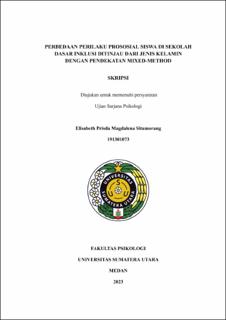| dc.contributor.advisor | Mukhtar, Desvi Yanti | |
| dc.contributor.author | Situmorang, Elisabeth Prisda Magdalena | |
| dc.date.accessioned | 2024-05-16T07:55:04Z | |
| dc.date.available | 2024-05-16T07:55:04Z | |
| dc.date.issued | 2023 | |
| dc.identifier.uri | https://repositori.usu.ac.id/handle/123456789/93290 | |
| dc.description.abstract | This study aims to determine the difference of student’s prosocial behavior
in incluaive elementary schools viewed from gender. This research is Mixed
Method research with a sequential explanation method. This study involved 90
students in grades 5-6 from SDN 4 Padang Genting located in Batubara City,
Sumatera Utara who was taken using purposive sampling. Data collection
techniques used scale “Scenario-Based Prosocial Intention Questionnaire
(SBPIQ)” created by Ampuni and Buwono (2022) based on Jackson and Tisak's
forms of prosocial behavior. Data analysis using statistics as an analysis technique
followed by interviews. Data in this study was analyzed by using an independent
sample t-test. The results showed that the female students (M = 81,89) in SDN 4
Padang Genting have a greater degree of prosocial behavior than the male
students (M = 75,63), with value of t = 3,336; p = 0.001 (p < 0,05). The results of
the analysis are then continued using interviews to describe the research results. | en_US |
| dc.language.iso | id | en_US |
| dc.publisher | Universitas Sumatera Utara | en_US |
| dc.subject | prosocial behavior | en_US |
| dc.subject | gender | en_US |
| dc.subject | elementary student | en_US |
| dc.subject | SDGs | en_US |
| dc.title | Perbedaan Perilaku Prososial Siswa di Sekolah Dasar Inklusi Ditinjau dari Jenis Kelamin dengan Pendekatan Mixed-Method | en_US |
| dc.title.alternative | The Difference of Student’s Prosocial Behavior in Inclusive Elementary Schools Viewed from Gender with Mixed-Method Approach | en_US |
| dc.type | Thesis | en_US |
| dc.identifier.nim | NIM191301073 | |
| dc.identifier.nidn | NIDN0015127501 | |
| dc.identifier.kodeprodi | KODEPRODI73201#Psikologi | |
| dc.description.pages | 115 Pages | en_US |
| dc.description.type | Skripsi Sarjana | en_US |




